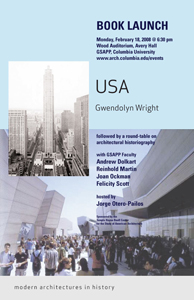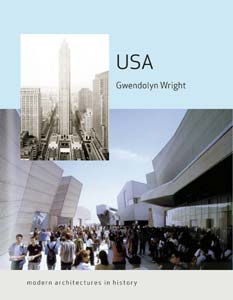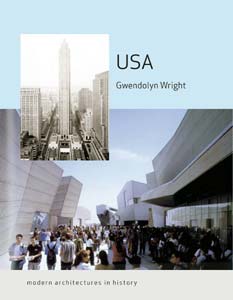by: Bill Millard
Event: Debate and Book Launch: USA: Modern Architectures in History (London: Reaktion Books, 2008)
Location: Columbia University, 02.18.08
Speakers: Gwendolyn Wright — Professor of Architecture, Planning and Preservation & Author, USA; Reinhold Martin — Associate Professor of Architecture, Director, Ph.D. Program in Architecture, Director, Master of Science Program in Advanced Architectural Design; Felicity Scott — Assistant Professor of Architecture; Joan Ockman — Adjunct Associate Professor of Architecture & Director, Temple Hoyne Buell Center for the Study of American Architecture; Andrew Dolkart — James Marston Fitch Professor of Historic Preservation, Columbia University Graduate School of Architecture, Planning and Preservation (GSAPP)
Moderator: Jorge Otero-Pailos — Assistant Professor of Historic Preservation, Columbia University GSAPP
Organizers: Columbia University GSAPP; Temple Hoyne Buell Center for the Study of American Architecture

In USA, a contribution to the British Modern Architectures in History series grounding the recent heritages of 14 nations in cultural and social perspectives, Gwendolyn Wright takes on the task of explaining American architectural history since the Civil War for an international audience. The argument she recounted before this panel of Columbia University colleagues takes a relatively familiar narrative — too often reduced to a major-figures parade, a greatest-hits collection chiefly based in three cities, and a set of formulas delivered by critical authorities — and expands it into a more nuanced palimpsest of forces. With an understanding of the ties between culture and the built environment, she reframes American Modernism as a broad-based, nationwide project of what she calls “radical incrementalism,” a more diffused, democratic form of progressive development rather than a top-down revolution by a select few, and much more than a simple translation of European Modernism.
Analyzing Modernism, modernization, and modernity (terms that Wright scrupulously defines in the book’s introduction) along national lines raises a contradiction for universalist theoreticians who saw Modernism in terms transcending national identities. Wright prefers a more inclusive view of actual building practices, influenced by distinct “national imaginaries,” or patterns of belief and self-awareness, as well as by each nation’s distinct material history.
America’s Modernism, as Wright sees it, combines broad cultural diversity with frank commercial influences, an active role for communications media shaping its public reception, and a longstanding environmental awareness. She tones down the conventional emphasis on supposedly pivotal events like the 1932 Museum of Modern Art exhibition, for example, finding that the social changes and specific programs ensuing from that same year’s election of President Franklin Roosevelt had greater effects on the public acceptance of modern architecture than the pronouncements of Philip Johnson and Henry-Russell Hitchcock. While not shortchanging major figures (Frank Lloyd Wright appears in every chapter until his death), she looks further afield to consider significant work by underappreciated architects, some female, many outside the Chicago-New York-Los Angeles metropolitan axis.
Her interlocutors, with few points of dissent (e.g., Felicity Scott’s objection that USA marginalizes Post-Modernism), provided opportunities for Wright to clarify her reasons for departing from received ideas, particularly ones assigning Modernism any decisive endpoint. Joan Ockman’s broad question — “What is modern, and when is modern? At the end of the book we’re back in modern, again, somehow” — challenged Wright to reposition the Modernist response as something more than momentary, beyond the implications of hyphenated styles. Wright’s book, sure to be incorporated into architecture school syllabi nationwide, indicates that she’s up to the challenge.
Bill Millard is a freelance writer and editor whose work has appeared in OCULUS, Icon, Content, The Architect’s Newspaper, and other publications.










